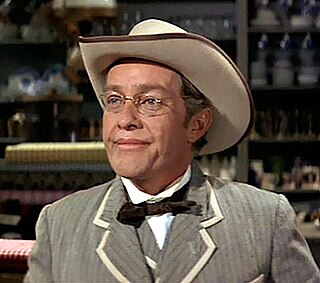
Strother Douglas Martin Jr. was an American character actor who often appeared in support of John Wayne and Paul Newman and in Western films directed by John Ford and Sam Peckinpah. Among Martin's memorable performances is his portrayal of the warden or "captain" of a state prison camp in the 1967 film Cool Hand Luke, in which he utters the line, "What we've got here is failure to communicate." The line is number 11 on the American Film Institute list of 100 Years...100 Movie Quotes.

The Adventures of Rin Tin Tin is an American children's Western television series that aired from October 1954 to May 1959 on the ABC television network. In all, 164 episodes aired. The show starred Lee Aaker as Rusty, a boy orphaned in an Indian raid, who was being raised by the soldiers at a US Cavalry post known as Fort Apache. Rusty and his German Shepherd dog, Rin Tin Tin, help the soldiers to establish order in the American West. James E. Brown appeared as Lieutenant Ripley "Rip" Masters. Co-stars included Joe Sawyer as Sergeant Biff O'Hara and Rand Brooks as Corporal Randy Boone.

Ken Curtis was an American actor and singer best known for his role as Festus Haggen on the CBS western television series Gunsmoke. He appeared on Gunsmoke earlier in other roles. His first appearance as Festus was in season 8, episode 13, "Us Haggens", which debuted December 8, 1962. His next appearance was Season 9, episode 2, October 5, 1963, as Kyle Kelly, in "Lover Boy". Curtis joined the cast of Gunsmoke permanently as Festus in "Prairie Wolfer", season 9 episode 16, which debuted January 18, 1964. The episode often is confused with a 1969 episode of the same title made five years later (S13E10).

Denver Dell Pyle was an American film and television actor and director. He was well known for a number of TV roles from the 1960s through the 1980s, including his portrayal of Briscoe Darling in several episodes of The Andy Griffith Show, as Jesse Duke in The Dukes of Hazzard from 1979 to 1985, as Mad Jack in the NBC television series The Life and Times of Grizzly Adams, and as the titular character's father, Buck Webb, in CBS's The Doris Day Show. In many of his roles, he portrayed either authority figures, or gruff, demanding father figures, often as comic relief. Perhaps his most memorable film role was that of Texas Ranger Frank Hamer in the movie Bonnie and Clyde (1967), as the lawman who relentlessly chased down and finally killed the notorious duo in an ambush.

Father Knows Best is an American sitcom starring Robert Young, Jane Wyatt, Elinor Donahue, Billy Gray and Lauren Chapin. The series, which began on radio in 1949, aired as a television show for six seasons and 203 episodes. Created by Ed James, Father Knows Best follows the lives of the Andersons, a middle-class family living in the town of Springfield. The state in which Springfield is located is never specified, but it is generally accepted to be located in the Midwestern United States.
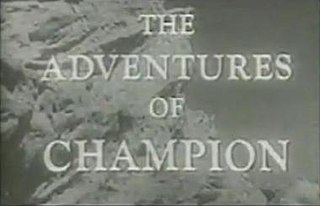
The Adventures of Champion is an American children's Western television series that aired from September 23, 1955, to March 3, 1956, for 26 episodes on CBS. In the United Kingdom, the series was re-broadcast under the title Champion the Wonder Horse. The series was repeated on and off by the BBC in the UK throughout the 70s, 80s and early 90s, with its final BBC broadcast being the episode "The Stone Heart" on 23 January 1993.
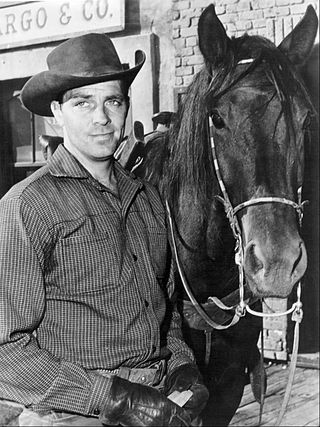
Dayle Lymoine Robertson was an American actor best known for his starring roles on television. He played the roving investigator Jim Hardie in the television series Tales of Wells Fargo and railroad owner Ben Calhoun in Iron Horse. He often was presented as a deceptively thoughtful but modest Western hero. From 1968 to 1970, Robertson was the fourth and final host of the anthology series Death Valley Days. Described by Time magazine in 1959 as "probably the best horseman on television", for most of his career, Robertson played in western films and television shows—well over 60 titles in all.

Ann Robinson is an American former actress and stunt horse rider, perhaps best known for her work in the science-fiction classic The War of the Worlds (1953) and in the 1954 film Dragnet, in which she starred as a Los Angeles police officer opposite Jack Webb and Ben Alexander.
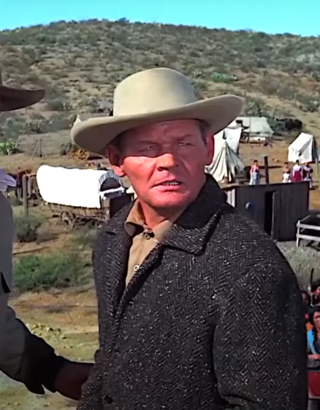
Leo Vincent Gordon was an American character actor and screenwriter. During more than 40 years in film and television he was most frequently cast as a supporting actor playing brutish bad guys but occasionally played more sympathetic roles just as effectively.

William Henry Wright was an American actor. He was frequently cast in Westerns and as a curmudgeonly and argumentative old man. Over the course of his career, Wright appeared in more than 200 film and television roles.
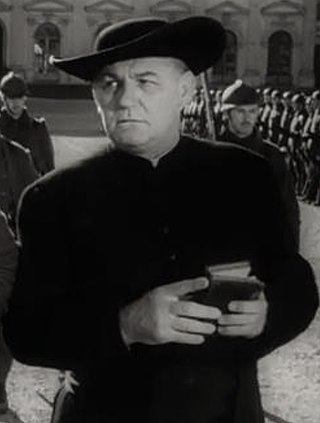
Emile Meyer was an American actor, usually known for tough, aggressive, authoritative characters in Hollywood films from the 1950s era, mostly in Westerns or thrillers.

The Roy Rogers Show is an American Western television series starring Roy Rogers. 100 episodes were broadcast on NBC for six seasons between December 30, 1951, and June 9, 1957. The episodes were set in the prevailing times (1950s) in the style of a neo-Western, rather than the Old West. Various episodes are known to be in the public domain today, being featured in low-budget cable television channels and home video.

Ray "Crash" Corrigan was an American actor most famous for appearing in many B-Western movies. He also was a stuntman and frequently acted as silver screen gorillas using his own gorilla costumes.
Frontier Doctor is an American Western television series starring Rex Allen that aired in syndication from September 26, 1958, until June 20, 1959. The series was also known as Unarmed and Man of the West.

Roger Lance Mobley is a former child actor in the 1950s and 1960s who made more than 118 television appearances and co-starred in nine feature films in a nine-year career. He served in the Green Berets during the Vietnam War, and was subsequently a police officer in Beaumont, Texas.

The Lone Ranger is an American Western television series that aired on the ABC Television network from 1949 to 1957, with Clayton Moore in the starring role. Jay Silverheels, a member of the Mohawk Aboriginal people in Canada, played The Lone Ranger's Indian companion Tonto.

Sky King was an American radio and television series. Its lead character was Arizona rancher and aircraft pilot Schuyler "Sky" King.

Robert LeRoy Diamond was an American actor active in the 1950s and 1960s before retiring from the profession and becoming a lawyer. He is best known as the child lead in the television series Fury.

William Fawcett Thompson was an American character actor who appeared in hundreds of films and television episodes. Because there were other actors named William Thompson he used his first and middle name when seeking acting roles. He was best known for playing Pete Wilkey in the television series Fury which ran from 1955 to 1960.

















